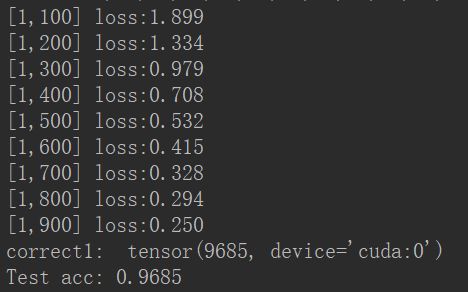记得第一次接触手写数字识别数据集还在学习TensorFlow,各种sess.run(),头都绕晕了。自从接触pytorch以来,一直想写点什么。曾经在2017年5月,Andrej Karpathy发表的一篇Twitter,调侃道:l've been using PyTorch a few months now, l've never felt better, l've more energy.My skin is clearer. My eye sight has improved。确实,使用pytorch以来,确实感觉心情要好多了,不像TensorFlow那样晦涩难懂。迫不及待的用pytorch实战了一把MNIST数据集,构建LeNet神经网络。话不多说,直接上代码!
import torch import torch.nn as nn import torch.nn.functional as F import torch.optim as optim from torchvision import datasets,transforms import torchvision from torch.autograd import Variable from torch.utils.data import DataLoader import cv2 class LeNet(nn.Module): def __init__(self): super(LeNet, self).__init__() self.conv1 = nn.Sequential( nn.Conv2d(1, 6, 3, 1, 2), nn.ReLU(), nn.MaxPool2d(2, 2) ) self.conv2 = nn.Sequential( nn.Conv2d(6, 16, 5), nn.ReLU(), nn.MaxPool2d(2, 2) ) self.fc1 = nn.Sequential( nn.Linear(16 * 5 * 5, 120), nn.BatchNorm1d(120), nn.ReLU() ) self.fc2 = nn.Sequential( nn.Linear(120, 84), nn.BatchNorm1d(84),#加快收敛速度的方法(注:批标准化一般放在全连接层后面,激活函数层的前面) nn.ReLU() ) self.fc3 = nn.Linear(84, 10) # self.sfx = nn.Softmax() def forward(self, x): x = self.conv1(x) x = self.conv2(x) # print(x.shape) x = x.view(x.size()[0], -1) x = self.fc1(x) x = self.fc2(x) x = self.fc3(x) # x = self.sfx(x) return x device = torch.device('cuda' if torch.cuda.is_available() else 'cpu') batch_size = 64 LR = 0.001 Momentum = 0.9 # 下载数据集 train_dataset = datasets.MNIST(root = './data/', train=True, transform = transforms.ToTensor(), download=False) test_dataset =datasets.MNIST(root = './data/', train=False, transform=transforms.ToTensor(), download=False) #建立一个数据迭代器 train_loader = torch.utils.data.DataLoader(dataset = train_dataset, batch_size = batch_size, shuffle = True) test_loader = torch.utils.data.DataLoader(dataset = test_dataset, batch_size = batch_size, shuffle = False) #实现单张图片可视化 # images,labels = next(iter(train_loader)) # img = torchvision.utils.make_grid(images) # img = img.numpy().transpose(1,2,0) # # img.shape # std = [0.5,0.5,0.5] # mean = [0.5,0.5,0.5] # img = img*std +mean # cv2.imshow('win',img) # key_pressed = cv2.waitKey(0) net = LeNet().to(device) criterion = nn.CrossEntropyLoss()#定义损失函数 optimizer = optim.SGD(net.parameters(),lr=LR,momentum=Momentum) epoch = 1 if __name__ == '__main__': for epoch in range(epoch): sum_loss = 0.0 for i, data in enumerate(train_loader): inputs, labels = data inputs, labels = Variable(inputs).cuda(), Variable(labels).cuda() optimizer.zero_grad()#将梯度归零 outputs = net(inputs)#将数据传入网络进行前向运算 loss = criterion(outputs, labels)#得到损失函数 loss.backward()#反向传播 optimizer.step()#通过梯度做一步参数更新 # print(loss) sum_loss += loss.item() if i % 100 == 99: print('[%d,%d] loss:%.03f' % (epoch + 1, i + 1, sum_loss / 100)) sum_loss = 0.0 #验证测试集 net.eval()#将模型变换为测试模式 correct = 0 total = 0 for data_test in test_loader: images, labels = data_test images, labels = Variable(images).cuda(), Variable(labels).cuda() output_test = net(images) # print("output_test:",output_test.shape) _, predicted = torch.max(output_test, 1)#此处的predicted获取的是最大值的下标 # print("predicted:",predicted.shape) total += labels.size(0) correct += (predicted == labels).sum() print("correct1: ",correct) print("Test acc: {0}".format(correct.item() / len(test_dataset)))#.cpu().numpy()
本次识别手写数字,只做了1个epoch,train_loss:0.250,测试集上的准确率:0.9685,相当不错的结果。
